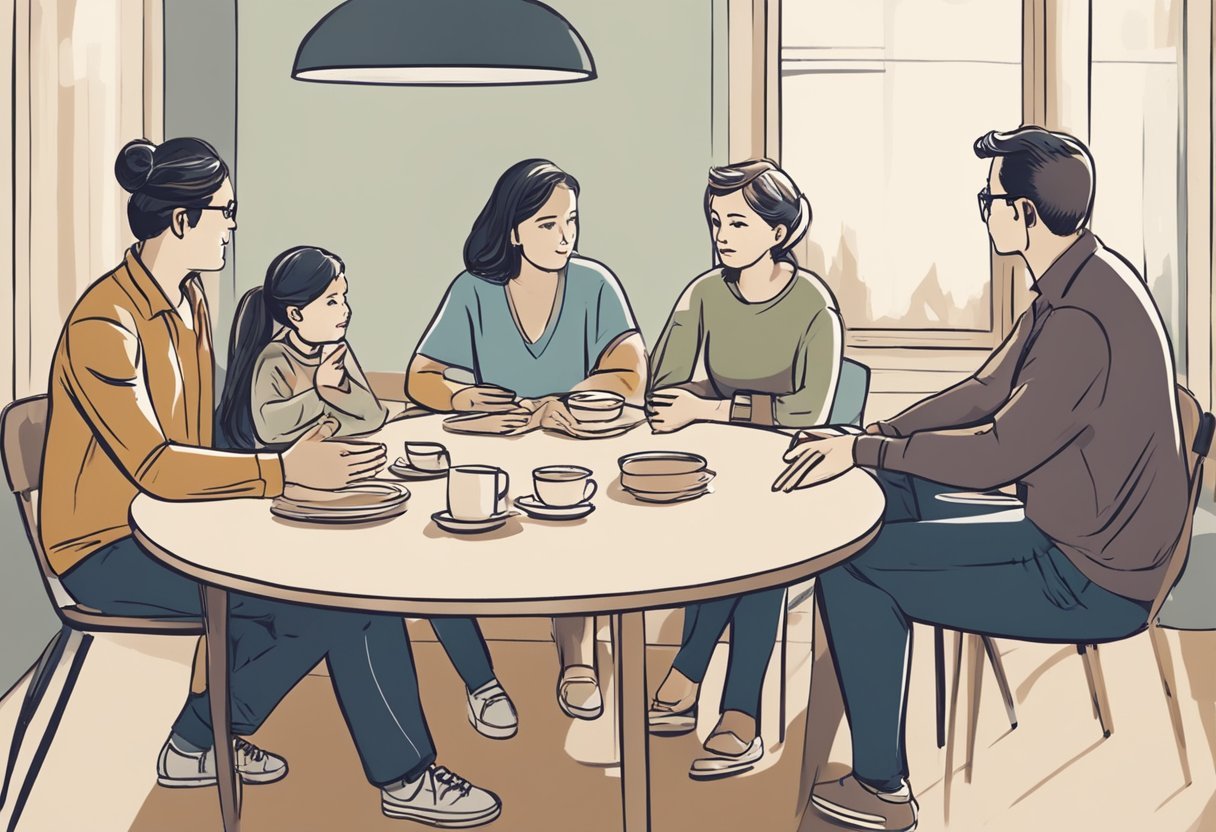Talking about family can be a fun and meaningful way to connect with others. Family members shape who people are, from their background to their daily lives. Understanding how to describe family relationships makes it easier to share personal stories and experiences.

Family Member
Many aspects help define family dynamics, from immediate relatives to extended branches. Knowing how to discuss each member adds depth to conversations, making them more engaging. Families also provide support systems that influence personal identity and experiences.
Key Takeaways
- Clear descriptions enhance understanding of family relationships.
- Family discussions can reveal significant life events.
- Family communication plays a key role in building connections.
The Basics of Family Dynamics

Family dynamics refer to the patterns of interaction among family members. These interactions are influenced by emotions, behaviors, and communication styles.
Key elements include:
- Roles: Each member plays a specific role, such as caregiver, provider, or peacemaker. These roles can change over time.
- Expectations: Families have expectations about behaviour. Members might feel pressure to meet these expectations, which can affect relationships.
- Communication: Open communication helps families understand each other. Poor communication can lead to misunderstandings and conflict.
Family dynamics can shift with major life events. For instance, events like weddings or divorces often change how members relate to each other. New family members can bring fresh perspectives, altering old patterns.
Stress from outside sources also affects family dynamics. Work, school, and social pressures can add strain to relationships. Families that manage stress well create a supportive environment.
According to Psychology Today, close family relationships often lead to better health and well-being. Families that navigate challenges together tend to have stronger bonds.
Understanding family dynamics is essential for building healthy relationships. It allows members to recognize their strengths and areas for improvement. These insights can lead to deeper connections and better communication.
Describing My Immediate Family

When talking about immediate family, it is useful to mention the key members. Typically, this includes parents, siblings, and sometimes a spouse or children.
Family Members
- Father: He is often the head of the household. He works hard to support the family.
- Mother: She usually takes care of the home. She might also work outside the home.
- Siblings: These are brothers and sisters. They can be younger or older. They share a special bond.
- Spouse: If married, one may describe their partner. This person is often a key part of the family.
- Children: Parents can also talk about their kids. They may share stories about their activities and interests.
Example Descriptions
- Father: “My father is a teacher. He enjoys helping students learn.”
- Mother: “My mother is a nurse. She cares for patients with great passion.”
- Brother: “I have one brother. He loves playing soccer.”
- Sister: “My sister is an artist. She often paints in her free time.”
Describing family is important for building connections. It helps to share who they are and what they like to do.
Extended Family Members

Extended Family Members
Extended family members include relatives beyond the immediate family, such as grandparents, aunts, uncles, and cousins. They play an important role in one’s life and can vary in closeness and involvement.
Common Terms for Extended Family:
- Grandparents: A person’s grandfather or grandmother.
- Aunts and Uncles: The siblings of one’s parents. They can be related by blood or marriage.
- Cousins: The children of a person’s aunts and uncles. They can be first cousins, second cousins, and so on.
Many people also have closer relationships with family friends who are called “Aunt” or “Uncle.” These titles show affection and respect, even if there is no blood relation.
It is vital to maintain connections with extended family. Regular check-ins can strengthen these bonds. This can involve simple messages or family gatherings.
Understanding different family structures is helpful. Some families may have diverse backgrounds, which can affect communication styles and traditions.
Tips for Engaging with Extended Family:
- Ask Questions: This helps to know their experiences and views.
- Share Interests: Discuss common hobbies or memories.
- Be Respectful: Acknowledge different perspectives and traditions.
Connecting with extended family enriches relationships and provides a support network.
Exploring Ancestry and Lineage
Ancestry and lineage are essential parts of understanding family history. They help individuals connect with their roots and learn about their ancestors. Many people are curious about where their family came from and how they fit into their family’s story.
To begin exploring ancestry, one useful step is to interview family members. This can uncover valuable stories and details about previous generations. These stories can provide insights into traditions and values that have been passed down.
Using online platforms can also enhance research. Websites like Ancestry and FamilySearch offer tools to build family trees. Users can piece together their family’s past by tracking relationships and important life events.
Key terms in exploring ancestry include:
- Consanguinity: Refers to blood relations, like parents, siblings, and cousins.
- Affinal relationships: These are connections by marriage, like in-laws.
Creating a family tree diagram can help visualize these connections. A simple layout might include:
| Relationship | Example |
|---|---|
| First Cousin | Shares grandparents |
| Second Cousin | Shares great-grandparents |
| Removed Cousin | Indicates a generational gap |
Understanding these connections enriches family narratives and strengthens bonds. Exploring ancestry can be a rewarding journey that connects individuals with their heritage.
Significant Life Events

Significant life events shape family dynamics and individual identities. These events can include marriages, births, graduations, and even losses.
Common Significant Life Events
- Marriage: Joining two families together often leads to new traditions and shared experiences.
- Births: The arrival of a child brings joy and changes to family routines. It is often celebrated with family gatherings.
- Graduations: Achievements in education mark important milestones, reflecting hard work and dedication.
- Loss: The passing of a family member can deeply affect everyone. It often leads to a time of reflection and remembrance.
Impact on Families
These events can strengthen family bonds. They create opportunities for families to come together and support each other.
Families may celebrate by hosting parties or creating special traditions. For instance, celebrating yearly anniversaries of significant events can keep memories alive.
In contrast, challenges like loss may require families to lean on one another more closely. Emotional support becomes vital during these times.
Recognizing and sharing these events helps family members understand each other better. It builds a stronger connection between them as they navigate life’s changes together.
Communication in the Family

Communication in the Family
Effective communication is vital in family life. It helps build strong connections and resolve conflicts. Families benefit from open discussions where everyone feels heard.
Active listening is essential. When family members genuinely listen to each other, it shows respect and understanding. This practice can lead to deeper relationships.
Using clear and simple language helps avoid misunderstandings. Families should encourage each other to express thoughts and feelings honestly. A positive atmosphere can make sharing easier.
Key strategies for good communication include:
- Respecting each other’s opinions
- Using “I” statements to express feelings
- Setting aside time for family discussions
Positive communication can influence how family members feel about each other. A thoughtful word can nurture trust and strengthen bonds.
Family meetings can be a great way to improve communication. During these gatherings, everyone can share experiences and discuss concerns. They provide a platform for family members to express themselves and listen actively.
Healthy communication also involves empathy. Family members should try to understand each other’s perspectives. This approach fosters a supportive environment where everyone feels valued.
In summary, strong communication skills contribute to a positive family dynamic. By practising these skills, families can create a more harmonious and connected home.
Family Conflict and Resolution

Family conflict can arise for many reasons, such as differences in opinions, values, or desires. Understanding how to address these conflicts is important for maintaining healthy family dynamics.
Here are some common strategies to help resolve family conflicts:
- Active Listening: This involves hearing different points of view without interrupting. It helps family members feel valued.
- Respectful Communication: Using kind words and a calm tone can reduce tension. It is important to express feelings without blame.
- Identify the Problem: Clearly defining what the conflict is can help everyone understand the issue at hand. Specificity leads to effective solutions.
Conflict Resolution Tips:
- Stay Calm: Emotions can escalate conflicts, so taking deep breaths is helpful.
- Set Boundaries: It’s crucial to create safe spaces for discussions, especially if emotions run high.
- Seek Win-Win Solutions: Finding a compromise that meets everyone’s needs can strengthen family bonds.
Involving a neutral third party can also be beneficial if the conflict seems overwhelming. Sometimes professional help from a family therapist can guide family members through tough discussions.
Using these strategies helps families navigate conflicts and fosters stronger relationships in the long run.
Support Systems Within the Family

A support system within a family is essential for emotional health. Family members provide help in various ways, like listening, sharing experiences, and celebrating achievements.
Key Benefits of Family Support:
- Emotional Support: Family members can make each other feel better during tough times. They share happiness and comfort through challenges.
- Problem-Solving: Families often work together to solve issues. This teamwork can build strong problem-solving skills.
- Traditions and Bonds: Family traditions create a sense of belonging. They help members connect with past and present experiences.
Ways to Strengthen Family Support:
- Express Appreciation: Regularly saying “thank you” helps strengthen connections. Compliments can uplift family members.
- Quality Time: Spending meaningful time together fosters closeness. Simple activities like family meals or game nights are beneficial.
- Open Communication: Encouraging family discussions helps everyone feel heard. Sharing thoughts and feelings enhances understanding.
Building a strong support system in a family leads to resilience. This system helps members cope with life’s ups and downs together. Understanding each other’s needs is vital for lasting relationships.
The Impact of Family on Personal Identity
Family plays a crucial role in shaping personal identity. From a young age, individuals learn values and beliefs from their family members. These lessons often influence how they see themselves and interact with the world.
When families share stories, it creates a sense of belonging. Hearing about family histories helps people understand their roots. This connection can strengthen their identity. For example:
- Cultural Traditions: Families pass down customs that contribute to a person’s cultural identity.
- Shared Experiences: Family experiences, such as vacations or challenges, help form strong bonds.
Additionally, communication within a family impacts self-perception. Positive feedback can boost confidence, while criticism may lead to self-doubt. Children learn to identify their strengths and weaknesses through their family’s eyes.
Family dynamics also play a role. Relationships with siblings, parents, and extended family members help shape social identity. For instance, relationships can teach conflict resolution and cooperation.
Lastly, the influence of family often extends into adulthood. Many adults find that their family’s ideals continue to guide their choices and behaviors. This ongoing impact shows the lasting power of family in forming who a person is throughout their life.
Frequently Asked Questions
This section covers common inquiries about discussing family members. It provides practical advice and examples to help improve family conversations.
How can I describe my family in five sentences?
To describe a family in five sentences, start with the family’s structure. Mention who is in the family, like parents, siblings, or children. Next, include one or two details about each member, such as their interests or personalities. Finally, summarize how the family enjoys spending time together.
What are some examples of explaining family relationships in English?
In English, a speaker could say, “My sister is a teacher.” This shows the relationship between siblings and their professions. Another example might be, “My uncle is married to my aunt.” This illustrates the connection between family members and their spouses.
What’s an effective way to introduce my family members in a conversation?
When introducing family members, it helps to start with the closest relatives. Begin with parents, then siblings, followed by extended family. For example, “This is my mother, Jane, and my father, Tom. I also have a brother, Alex, who loves soccer.” This makes introductions clearer and more organized.
How should one handle a family that doesn’t communicate well with each other?
For families that struggle with communication, patience is key. Encouraging open discussions can promote understanding. It may help to suggest family meetings where everyone can share thoughts and feelings in a safe environment. Gradually, this may improve interactions over time.
Can you provide a short dialogue to illustrate a typical conversation about family?
Sure! Here’s a simple dialogue:
Person A: “Can you tell me about your family?”
Person B: “Of course! I have two siblings. My brother is studying engineering and my sister is in high school. My parents are both teachers.”
What strategies are effective for responding to negative or toxic comments from family members?
Responding to negative comments requires calmness and assertiveness. One strategy is to set boundaries by stating, “I prefer not to discuss that.” If negativity continues, it may be necessary to walk away from the conversation. Practising self-care afterwards can help manage any stress caused by the interaction.
Read More About – Counting Made Easy: Learn Numbers 1-100







Leave a Comment